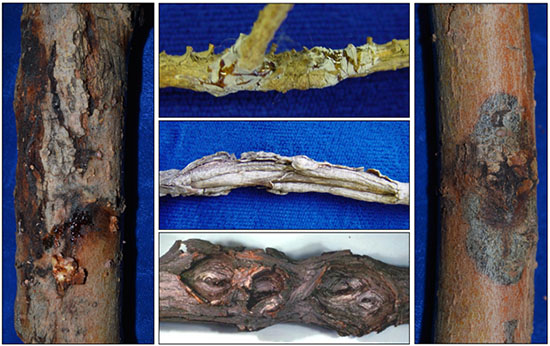Issue 3, May 9, 2016
Scouting for Cankers
Trees and shrubs in Illinois have had a hard couple of years. We had two years of back-to-back drought several summers ago, followed by some harsh winters and then last year's record-setting wet spring. All-in-all, our plants are pretty stressed.

Various fungal cankers on woody stems. Photo credit: University of Illinois Plant Clinic
We've been seeing a lot of cankers at the Plant Clinic recently. Cankers are localized areas of dead tissue, and they show up on stems, trunks, and branches. Cankers can be sunken or swollen, and may bleed (or ooze) sap. The bark may be split or cracked. The term "canker" describes a symptom; there can be many causes, including fungi, bacteria, and mechanical damage. Fungal and bacterial cankers tend to show up on stressed trees. These are pathogens that are ubiquitous in the environment, so attempting to control the pathogen is usually not helpful. Once a canker pathogen has invaded the stressed plant, it begins to damage the vascular system. This can lead to dieback and death due to girdling.

Non-pathogenic canker caused by frost cracking damage at base of young tree. Photo credit: Diane Plewa, University of Illinois Plant Clinic
We recommend scouting trees for cankers by carefully examining the trunk and base of major branches. Look for areas of disrupted bark, or discoloration. A common fungal canker of spruce and pine causes a white, sticky exudate to drip down branches and the trunk. While there isn't much you can do about a canker – no pesticides have been found to be effective, and wound dressings are not recommended – they can be used as a gauge for how stressed your trees are. The best management for cankers is prevention: try to reduce stress on your trees! We recommend lightly mulching the base of trees (this has the benefits of maintaining even soil moisture and reducing the likelihood of a mower or trimmer damaging the trunk), fertilizing when appropriate (late fall and early spring for most), watering during periods of dryness lasting more than 2 weeks in the summer, and pruning out dead wood in dry weather. If you have recently installed a tree or shrub, remember that transplant care lasts more than one season and the plants should be actively maintained (including watering) for 3 years. (Diane Plewa)
Author:
Diane Plewa